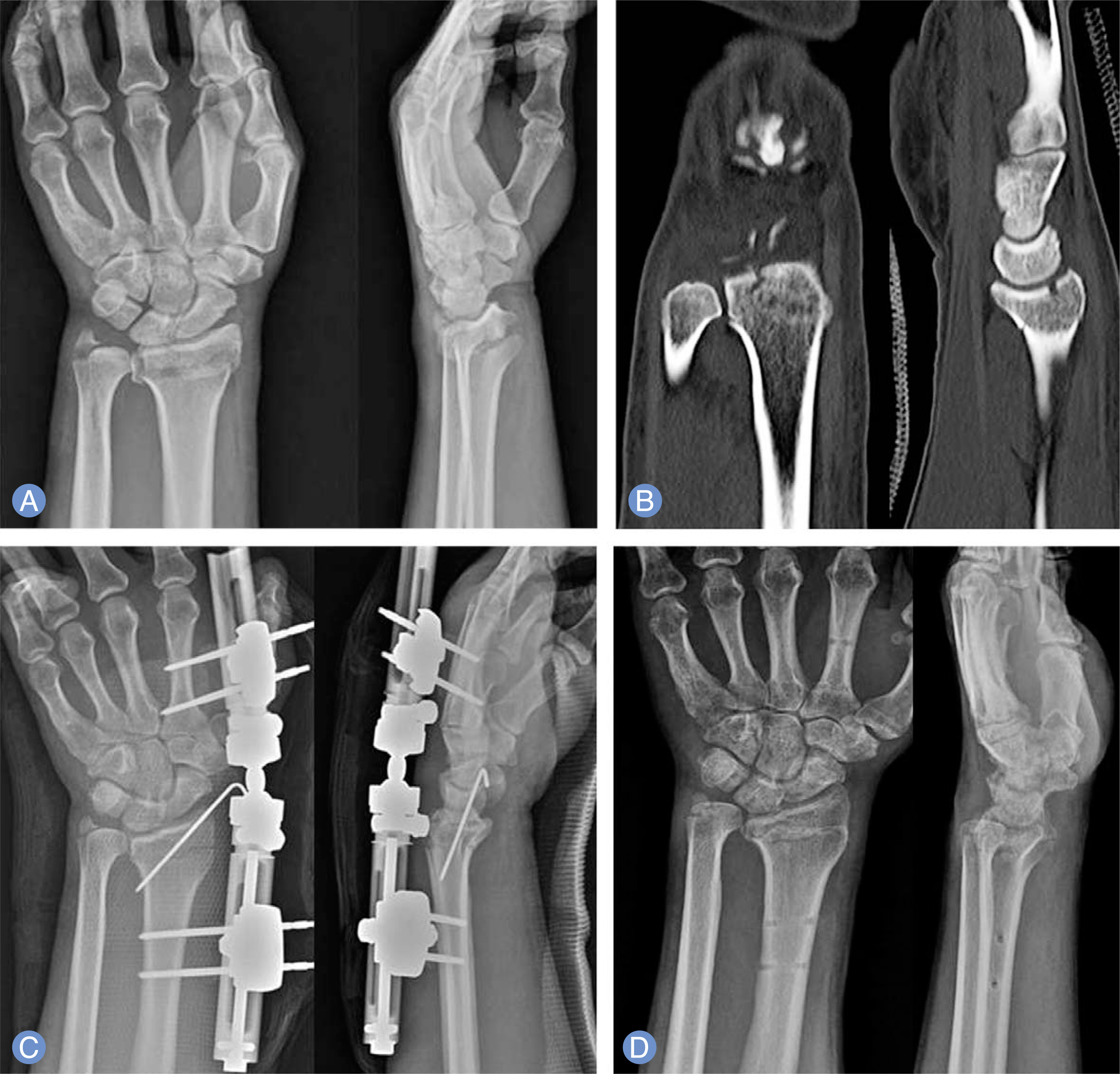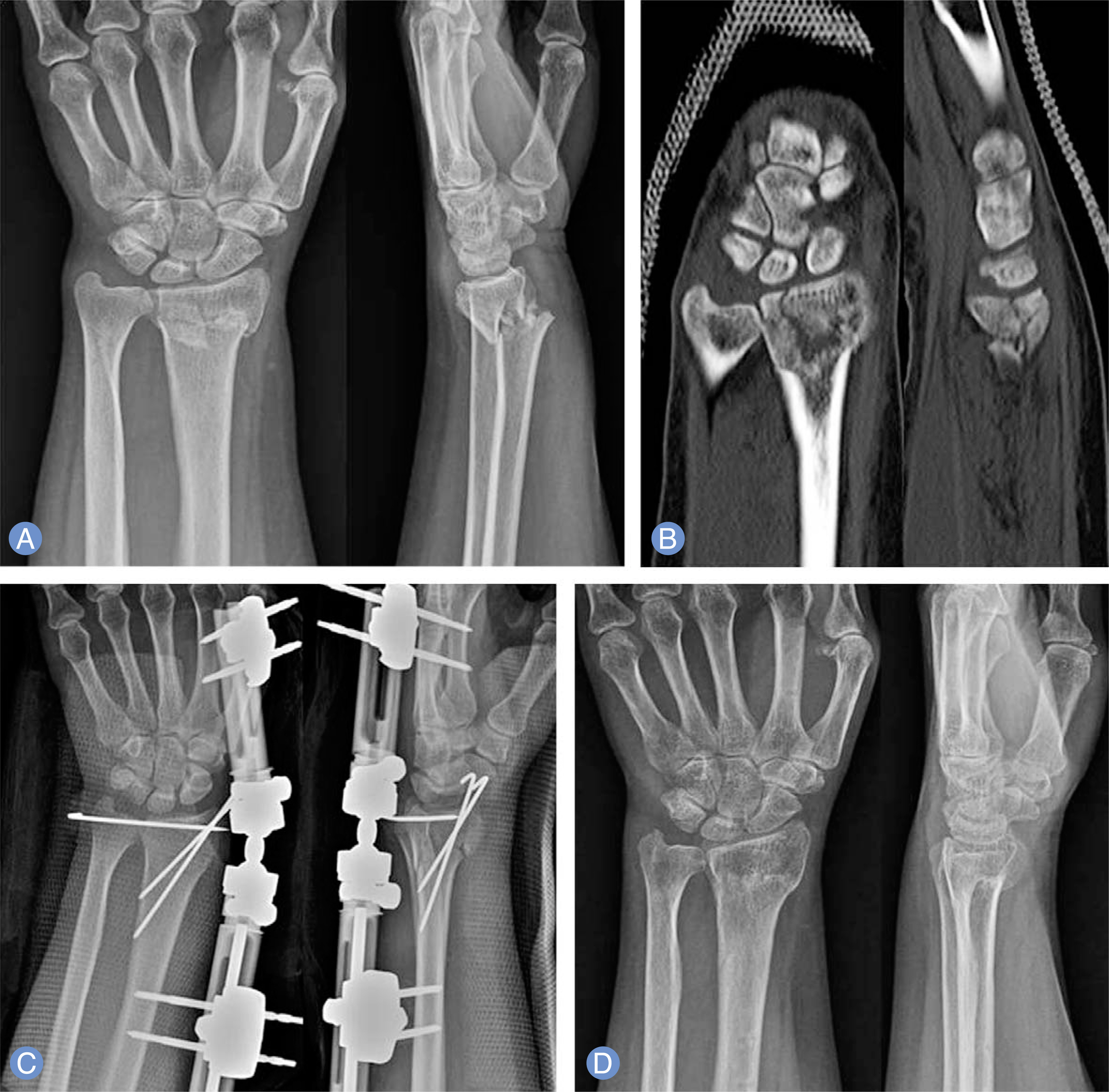J Korean Soc Surg Hand.
2015 Mar;20(1):15-22. 10.12790/jkssh.2015.20.1.15.
Efficacy of External Fixation and Transfixation Pinning of Distal Radioulnar Joint in Distal Radius Fracture
- Affiliations
-
- 1Department of Orthopaedic Surgery, Kwang-Myeong Sung-Ae Hospital, Seoul, Korea. java5885@gmail.com
- KMID: 2194121
- DOI: http://doi.org/10.12790/jkssh.2015.20.1.15
Abstract
- PURPOSE
The purpose of this study is to evaluate efficacy of percutaneous pinning of distal radioulnar joint in patient with distal radius fracture.
METHODS
Thirty-eight patients who underwent percutaneous pinning and external fixation for distal radius fracture were included in this study. Radiologic and clinical outcomes were compared between the patients who underwent percutaneous pinning on the radius only (PD group) and the patients with supplementary pinning on distal radioulnar joint (DRU group) after percutaneous pinning on the radius. External fixation was performed in all patients.
RESULTS
Twenty-three patients were PD group and fifteen patients were DRU group. Radial height and radial inclination was significantly higher in DRU group. There was no significant difference in ulnar variance, volar tilt and articular step off between two groups. Among the clinical outcome, there was no significant difference in range of motion between two groups but grip strength was significantly larger in DRU group.
CONCLUSION
Percutaneous pinning with K-wires on distal radioulnar joint in distal radius fracture can be a useful procedure for prevention of radial shortening without loss of range of motion of the wrist.
Figure
Reference
-
References
1. Chung KC, Spilson SV. The frequency and epidemiology of hand and forearm fractures in the United States. J Hand Surg Am. 2001; 26:908–15.
Article2. Park C, Ha YC, Jang S, Jang S, Yoon HK, Lee YK. The incidence and residual lifetime risk of osteoporosis-related fractures in Korea. J Bone Miner Metab. 2011; 29:744–51.
Article3. Azzopardi T, Ehrendorfer S, Coulton T, Abela M. Unstable extra-articular fractures of the distal radius: a prospective, randomised study of immobilisation in a cast versus supplementary percutaneous pinning. J Bone Joint Surg Br. 2005; 87:837–40.4. Cooney WP 3rd, Linscheid RL, Dobyns JH. External pin fixation for unstable Colles' fractures. J Bone Joint Surg Am. 1979; 61:840–5.
Article5. Fitoussi F, Ip WY, Chow SP. Treatment of displaced intra-articular fractures of the distal end of the radius with plates. J Bone Joint Surg Am. 1997; 79:1303–12.
Article6. Handoll HH, Madhok R. Surgical interventions for treating distal radial fractures in adults. Cochrane Database Syst Rev. 2003; (3):CD003209.
Article7. Horne G. A prospective randomized trial of external fixation and plaster cast immobilization in the treatment of distal radius fractures. J Orthop Trauma. 1991; 5:246.8. Kapoor H, Agarwal A, Dhaon BK. Displaced intra-articular fractures of distal radius: a comparative evaluation of results following closed reduction, external fixation and open reduction with internal fixation. Injury. 2000; 31:75–9.
Article9. Kreder HJ, Hanel DP, Agel J, et al. Indirect reduction and percutaneous fixation versus open reduction and internal fixation for displaced intra-articular fractures of the distal radius: a randomised, controlled trial. J Bone Joint Surg Br. 2005; 87:829–36.10. Bartosh RA, Saldana MJ. Intraarticular fractures of the distal radius: a cadaveric study to determine if ligamentotaxis restores radiopalmar tilt. J Hand Surg Am. 1990; 15:18–21.
Article11. Ark J, Jupiter JB. The rationale for precise management of distal radius fractures. Orthop Clin North Am. 1993; 24:205–10.
Article12. Howard PW, Stewart HD, Hind RE, Burke FD. External fixation or plaster for severely displaced comminuted Colles' fractures? A prospective study of anatomical and functional results. J Bone Joint Surg Br. 1989; 71:68–73.
Article13. Jenkins NH, Jones DG, Johnson SR, Mintowt-Czyz WJ. External fixation of Colles' fractures. An anatomical study. J Bone Joint Surg Br. 1987; 69:207–11.14. McQueen M, Caspers J. Colles fracture: does the anatomical result affect the final function? J Bone Joint Surg Br. 1988; 70:649–51.
Article15. Bradway JK, Amadio PC, Cooney WP. Open reduction and internal fixation of displaced, comminuted intra-articular fractures of the distal end of the radius. J Bone Joint Surg Am. 1989; 71:839–47.
Article16. Knirk JL, Jupiter JB. Intra-articular fractures of the distal end of the radius in young adults. J Bone Joint Surg Am. 1986; 68:647–59.
Article17. Fernandez DL. Correction of post-traumatic wrist deformity in adults by osteotomy, bone-grafting, and internal fixation. J Bone Joint Surg Am. 1982; 64:1164–78.
Article18. Fernandez DL. Radial osteotomy and Bowers arthroplasty for malunited fractures of the distal end of the radius. J Bone Joint Surg Am. 1988; 70:1538–51.
Article19. Jupiter JB, Masem M. Reconstruction of post-traumatic deformity of the distal radius and ulna. Hand Clin. 1988; 4:377–90.
Article20. Kazuki K, Kusunoki M, Yamada J, Yasuda M, Shimazu A. Cineradiographic study of wrist motion after fracture of the distal radius. J Hand Surg Am. 1993; 18:41–6.
Article21. Jenkins NH, Mintowt-Czyz WJ. Mal-union and dysfunction in Colles' fracture. J Hand Surg Br. 1988; 13:291–3.
Article22. Palmer AK, Werner FW. Biomechanics of the distal radioulnar joint. Clin Orthop Relat Res. 1984; (187):26–35.
Article23. Altissimi M, Antenucci R, Fiacca C, Mancini GB. Longterm results of conservative treatment of fractures of the distal radius. Clin Orthop Relat Res. 1986; (206):202–10.
Article24. Hastings H 2nd, Leibovic SJ. Indications and techniques of open reduction. Internal fixation of distal radius fractures. Orthop Clin North Am. 1993; 24:309–26.25. Costa ML, Achten J, Parsons NR, et al. Percutaneous fixation with Kirschner wires versus volar locking plate fixation in adults with dorsally displaced fracture of distal radius: randomised controlled trial. BMJ. 2014; 349:4807.
Article26. Mah ET, Atkinson RN. Percutaneous Kirschner wire stabilisation following closed reduction of Colles' fractures. J Hand Surg Br. 1992; 17:55–62.
Article27. Glickel SZ, Catalano LW, Raia FJ, Barron OA, Grabow R, Chia B. Long-term outcomes of closed reduction and percutaneous pinning for the treatment of distal radius fractures. J Hand Surg Am. 2008; 33:1700–5.
Article28. Rozental TD, Blazar PE, Franko OI, Chacko AT, Earp BE, Day CS. Functional outcomes for unstable distal radial fractures treated with open reduction and internal fixation or closed reduction and percutaneous fixation. A prospective randomized trial. J Bone Joint Surg Am. 2009; 91:1837–46.
- Full Text Links
- Actions
-
Cited
- CITED
-
- Close
- Share
- Similar articles
-
- Comparison of Results According to the Type and Procedure in Unstable Fracture of the Distal Radius
- The significance of distal radioulnar joint injury in distal radius fracture
- Volar Dislocation of the Distal Radioulnar Joint Blocked by Displaced Dorsal Barton Fracture
- Surgical Treament for Unstable Intra-articular Fracture of the Distal Radius with Rayhack's Transulnar Percutaneous Pinning Technique
- Treatment of Comminuted Distal Radius Fracutures with External Skeletal Fixation



